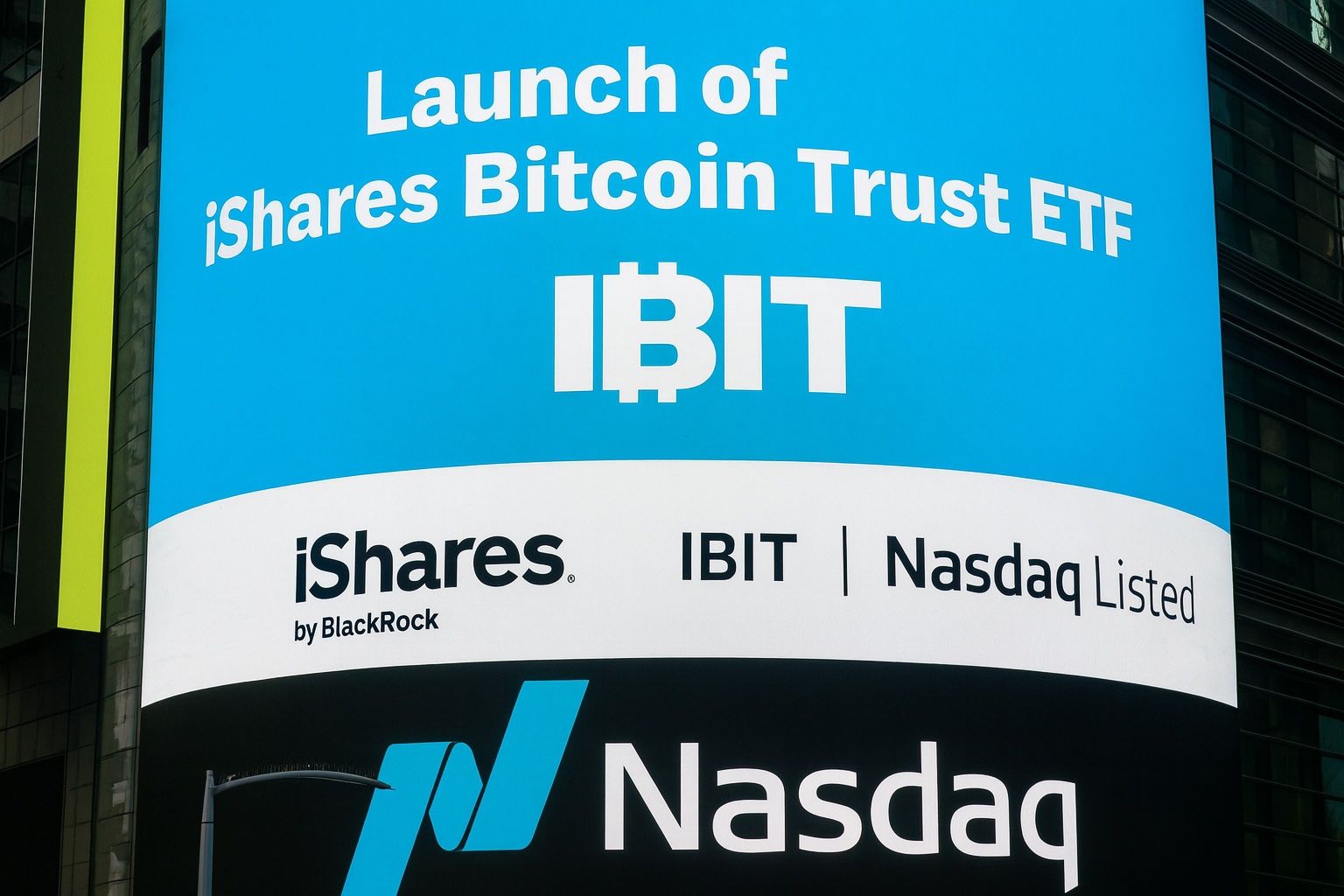- IBIT Stock Performance: The iShares Bitcoin Trust ETF (IBIT) is trading around $60.50 per share as of Oct. 18, 2025, after briefly touching the low-$70s earlier this month [1]. It slipped ~15% from its peak amid Bitcoin’s recent pullback, but remains up strongly year-to-date (roughly +15% YTD as of mid-October) [2].
- Bitcoin Price at $107K:Bitcoin (BTC) currently hovers near $107,000, up about 2–3% in the past 24 hours but still ~15% below its all-time high of ~$126,000 set in early October [3]. A mid-month flash crash – triggered by an unexpected U.S.–China trade clash – saw BTC plunge from ~$122K to ~$104K in hours [4], before stabilizing in the $105–$110K range.
- IBIT’s $100B Milestone:BlackRock’s IBIT has emerged as the world’s largest crypto ETF by far, with assets under management near the $85–$90 billion range after briefly surpassing $100 billion earlier this month [5]. IBIT’s explosive growth (launched late 2024) makes it one of the fastest-growing ETFs in history, on track to cross $100B in under two years – a feat that took traditional funds like Vanguard’s S&P 500 ETF over five years [6].
- Institutional Inflows & Adoption: Even as crypto markets cooled, IBIT continued to attract inflows when others saw outflows. Over a recent two-day span, IBIT pulled in ~$134 million new investment despite Bitcoin’s drop from $122K to $107K [7]. Overall U.S. Bitcoin ETFs did see a sharp one-day outflow (~$536M) on Oct. 17, breaking a two-week streak of inflows [8] [9], but BlackRock’s IBIT only lost a relatively modest $29M that day while a rival Fidelity fund saw far larger redemptions [10] [11]. Analysts note that total Bitcoin held by ETFs remains near record highs – these funds (plus public companies) now own roughly 12% of all BTC, underscoring deep institutional adoption [12].
- Competition & Market Impact: BlackRock dominates the Bitcoin ETF space, with IBIT roughly 4× the size of the next largest spot Bitcoin fund (Fidelity’s Wise Origin Bitcoin Trust, ticker FBTC) [13]. Other players – from Grayscale’s long-running Bitcoin Trust (GBTC) to newer ETFs by Bitwise and Ark Invest – are “getting the crumbs” in terms of assets [14]. Grayscale’s product, once at a steep discount, now trades only ~10% below its Bitcoin holdings amid optimism it will convert to an ETF [15]. Industry-wide, crypto ETFs saw unprecedented inflows earlier in October (~$5.95B in one week) fueling the rally [16] [17], though the recent volatility tempered flows as some investors took profits.
- Major News Drivers:Regulatory and macroeconomic news are swinging sentiment. BlackRock’s CEO Larry Fink touted the firm’s crypto ETFs crossing $100B as proof of surging demand [18] [19]. U.S. regulators have streamlined crypto ETF approvals, prompting a wave of new filings (for Ethereum, Solana, XRP funds, etc.) under a clearer framework [20]. Meanwhile, geopolitical jitters – notably a U.S.–China tariff scare – and speculation around the Federal Reserve’s next move (odds of an October rate cut have climbed to ~65% [21]) injected volatility. Gold hit record highs above $4,200/oz as a safe haven [22], reflecting broader risk-off sentiment even as crypto bulls remain optimistic.
- Analyst Outlook: Despite turbulence, many experts remain bullish on Bitcoin and IBIT. Citi analysts this week reiterated a $133K year-end BTC target, citing resilient ETF buying even after the dip [23]. Standard Chartered still projects Bitcoin could reach ~$200K by end-2025 [24], and BlackRock’s own strategists noted nothing “structural” has changed in the crypto thesis [25]. Prominent investors like Arthur Hayes see the pullback as a “buying window” before a possible year-end rally [26]. Still, short-term sentiment is cautious: prediction markets put even odds on BTC dipping below $100K in the coming weeks [27], and veteran voices like Robert Kiyosaki warn of a potential 50% crash ahead of the next major surge [28]. In summary, long-term optimism (buoyed by upcoming catalysts like 2026’s Bitcoin halving and growing mainstream adoption) is tempered by near-term risks from macroeconomic and technical pressures.
IBIT Price and Recent Performance
BlackRock’s iShares Bitcoin Trust ETF (IBIT) has ridden Bitcoin’s rollercoaster in October. The fund’s share price currently sits around $60–61 (USD) [29], up modestly on the day but down from its early-month highs. In the first week of October, IBIT surged alongside Bitcoin’s “Uptober” rally – reaching the low $70s per share (its 52-week high was $71.32 [30]). But as Bitcoin retreated in mid-October, IBIT shares also pulled back roughly 15% from their peak. Even after the dip, IBIT is still well in the green for 2025. Year-to-date, the fund has returned on the order of +15–20% (and roughly +75–80% over the past 12 months) thanks to Bitcoin’s broader uptrend [31]. The 1-day NAV change on Oct. 17 was -1.42% [32], reflecting a market cooldown in recent days.
This volatility is unsurprising given IBIT’s mandate: the ETF is designed to track the price of Bitcoin itself [33]. As such, IBIT offers a pure play on BTC’s moves – delivering outsized gains during Bitcoin’s rallies, but also mirroring its downturns. For example, earlier this month Bitcoin’s rapid climb above $125K sent IBIT soaring (with heavy trading volumes), whereas the subsequent flash crash saw IBIT slip back down. Still, many investors prefer IBIT for Bitcoin exposure due to its convenience and liquidity. BlackRock charges a 0.25% annual fee [34], but in return, holders avoid the hassles of direct crypto custody, trading, and tax complexity. As the most traded Bitcoin exchange-traded product since launch, IBIT offers tight spreads and robust liquidity for even large trades [35]. In short, IBIT’s recent performance has been a microcosm of Bitcoin’s own wild month – a surge to record highs followed by a healthy correction – leaving the fund consolidating around the $60 level as of mid-October.
Bitcoin’s “Uptober” Rally and Flash Crash Context
The backdrop to IBIT’s October ride is Bitcoin’s dramatic price action. Bitcoin (BTC) entered October with strong momentum, living up to the “Uptober” moniker that crypto bulls often tout. By October 5–6, 2025, BTC exploded past $125,000 to set new all-time highs (~$126,300) amid a frenzy of institutional buying and ETF inflows [36] [37]. The rally saw Bitcoin gain over 10% in a matter of days, carrying the broader crypto market upward – Ethereum briefly topped $4,800 and numerous altcoins notched double-digit gains [38].
However, the exuberance met a sudden shock on October 10. In a surprise geopolitical twist, former President Donald Trump announced plans for 100% tariffs on all Chinese imports, far more aggressive than markets had anticipated [39]. The news acted as a gut-punch to risk assets. Within hours, a wave of “risk-off” panic selling hit crypto markets. Bitcoin plunged from about $122K to as low as ~$104K in a single day [40], one of the steepest intraday drops on record. This flash crash cascaded through the market: an estimated $19+ billion in leveraged positions were liquidated as over-leveraged traders got wiped out [41]. Ethereum and other coins also fell sharply – e.g. ETH dropped from the $4,000s to mid-$3,600s before bouncing [42]. By the next day (Oct. 11), Bitcoin stabilized in the mid-$100K range, down roughly 15% from its highs.
By October 18, Bitcoin has clawed back some losses to trade around $107,000 [43]. It’s roughly flat over the past 24 hours, but still down ~7% week-on-week. Analysts characterized the drop as a needed “deleveraging” reset rather than a fundamental collapse [44] [45]. “Nothing structural has really changed” in Bitcoin’s outlook, one market strategist noted [46] – the network and adoption metrics remain robust. In fact, long-term “HODLers” (coins held >1 year) now command an all-time high share of supply, suggesting loyal investors largely sat through the volatility [47]. The flash crash’s catalyst – trade war jitters – has also eased somewhat: by Oct. 12, Trump walked back the harshest rhetoric, calming markets [48]. But the episode was a reminder of Bitcoin’s notorious volatility. Even with improving macro trends (e.g. speculation the Fed may cut rates at its Oct. 29 meeting, which would typically boost Bitcoin [49]), BTC remains sensitive to sudden shocks. Crypto’s late-October mood is thus mixed: the $100K level held as support during the turmoil [50], bolstering the bulls’ case, but lingering macro uncertainties keep traders on guard for aftershocks.
IBIT’s Record Inflows and $100B Asset Milestone
One silver lining of the recent rally-and-dip is what it revealed about institutional demand via ETFs like IBIT. In early October, as Bitcoin sprinted to new highs, a tidal wave of capital flowed into crypto investment funds. According to CoinShares data, nearly $6 billion poured into digital asset products in just the first week of October – with about $3.5B of that going into Bitcoin-focused funds [51] [52]. BlackRock’s IBIT was a major magnet for these inflows, helping propel its assets under management toward an eye-popping milestone. Less than 22 months after launching, IBIT’s AUM swelled to roughly $97–100 billion by mid-October [53] [54]. That placed it among the 20 largest ETFs of any kind (only 18 funds in the world have $100B+ in assets) [55]. For context, flagship ETFs like SPY (S&P 500) or VOO (Vanguard S&P 500) took over five years to reach the $100B mark – IBIT was on pace to do it in under two years, making it arguably the fastest-growing ETF in history [56].
BlackRock’s executives have not been shy about trumpeting this success. CEO Larry Fink noted on an Oct. 17 earnings call that BlackRock’s digital asset ETFs went “from practically zero in 2023 to over $100 billion” in assets by 2025 [57]. The firm’s CFO, Martin Small, highlighted that IBIT (and its sister Ethereum ETF, ticker ETHA) were among the top five inflow leaders across the entire $7 trillion ETF industry [58] [59]. In other words, in 2025 these crypto funds attracted more new money than almost any traditional equity or bond ETF – a stunning indication of demand.
Even more telling is how IBIT behaved during the mid-October pullback. While crypto ETFs overall finally saw net outflows on Oct. 17 (the largest daily redemption since August) [60] [61], IBIT proved relatively resilient. Data show BlackRock’s fund experienced only about $29 million in outflows that day, versus much larger redemptions at some competitors like Fidelity’s fund (which lost ~$132M) [62] [63]. And in the days leading up to that, IBIT was still logging inflows. According to Yahoo Finance/SoSpoValue, IBIT saw 10 consecutive trading days of inflows through mid-October [64]. Even as Bitcoin fell from its highs, IBIT pulled in $134 million over two sessions (with ~$74M and $60M on consecutive days) while most other Bitcoin ETFs bled assets [65]. This indicates that some institutional investors were buying the dip via IBIT, underscoring BlackRock’s reputational edge.
Thanks to its massive asset base, IBIT has also become a profit engine for BlackRock. The ETF charges a 0.25% management fee [66], which on ~$90B in assets translates to roughly $225 million in annualized fee revenue. In fact, IBIT is now BlackRock’s single most profitable ETF, recently surpassing the firm’s long-standing equity funds. It’s earning about $25M more per year in fees than BlackRock’s next highest earner (the iShares Russell 1000 Growth fund), according to Bloomberg analysis [67] [68]. Every other BlackRock fund in the top fee-earners list has been around for over a decade – IBIT achieved this in under two years [69]. Little wonder, then, that BlackRock is exploring more crypto offerings: it filed in September to launch an “iShares Bitcoin Premium Income ETF,” which would generate yield by selling call options on BTC futures [70]. The crypto ETF wave appears to be just getting started, with BlackRock at the helm and IBIT as the flagship.
IBIT vs. Other Bitcoin ETFs: Grayscale, Bitwise, and the Rest
When it comes to Bitcoin investment vehicles, IBIT is in a league of its own. BlackRock’s behemoth fund now holds an estimated 1.3 million BTC (through custodians) – a stake so large it rivals the reserves of Satoshi-era crypto whales [71] [72]. In asset terms, IBIT’s ~$90B towers over the competition. The next-largest U.S. spot Bitcoin ETF is Fidelity’s Wise Origin Bitcoin Trust (FBTC), which is only about one-quarter the size of IBIT by assets [73]. (As of this month, FBTC’s AUM is roughly in the mid-$20 billions, versus IBIT near $90B.) After that comes a steep drop to the smaller players. Ark 21Shares Bitcoin ETF (ARKB), Bitwise Bitcoin ETF (BITB), and others each have just a few billion in assets or less [74]. Grayscale’s Bitcoin Trust (GBTC) – which for years was the primary institutional vehicle – held around $20B at its peak in 2021, but fell out of favor when its share price traded at a deep discount to the underlying BTC. Now, with spot ETFs like IBIT available, Grayscale has been seeking to convert GBTC into an ETF to stay competitive. Markets seem to expect this will happen: GBTC’s discount has narrowed to roughly 10% (much improved from the 30–40%+ discount seen in 2022) [75]. During the recent slump, GBTC’s discount didn’t blow out again – a sign that institutional holders aren’t rushing for the exits and anticipate a conversion or further normalization [76] [77].
Crypto analysts often quip that BlackRock eats first, others get crumbs. Tyrone Ross, an advisor and crypto expert, noted that BlackRock’s dominance in ETFs long predated crypto, and now “everyone else gets the crumbs” in the Bitcoin ETF space [78]. Still, those “crumbs” can be meaningful – the overall market is so large that even being #2 or #3 in crypto ETFs can mean tens of billions in assets. For instance, BlackRock’s Ethereum Trust (ETHA) has gathered about $16 billion itself [79] [80], making it the fourth-biggest crypto fund globally. Fidelity’s Bitcoin fund, while only a fraction of IBIT, has seen solid inflows and could grow if it differentiates (though BlackRock’s first-mover advantage and distribution might is hard to beat). Bitwise, VanEck, WisdomTree, Invesco, and others either have launched or are planning Bitcoin ETFs, but so far none have cracked even the $10B mark – collectively, they’re fighting over what one analyst called the “leftover crumbs” after IBIT’s feast [81].
One newer development is the proliferation of specialized crypto funds. While BlackRock has stayed focused on the two giants (Bitcoin and Ether), other issuers are rolling out products targeting a wider array of digital assets. For example, ARK Invest (with 21Shares) launched not only a Bitcoin ETF (ARKB) but has proposals for Ethereum and even Solana ETFs. Bitwise similarly has been pushing themed funds and even crypto index ETFs. And recently, the SEC’s rule changes (more on this below) opened the door for ETFs tied to assets like XRP, Litecoin, Chainlink, and more [82] [83]. So while IBIT currently dominates the landscape, the competitive field is likely to expand in late 2025 and 2026. Grayscale, for its part, is planning a suite of “Mini Trust ETFs” to convert its existing single-asset trusts (for BTC, ETH, etc.) into the ETF format [84]. If approved, that could instantly make Grayscale a major player again – their Bitcoin trust (ticker possibly changing to BTC) would become a direct competitor to IBIT, potentially with trillions of shares held by retail investors over the years. For now, though, IBIT is the heavyweight champ, with a market share and liquidity profile that outshines all rivals.
It’s also worth noting the futures-based ETFs in the mix. Before spot Bitcoin ETFs were allowed, funds like the ProShares Bitcoin Strategy ETF (BITO) offered exposure via futures contracts. BITO is still trading and even saw a spike in volume during the Oct. 10–11 turmoil as traders used it to hedge or speculate [85]. However, BITO’s assets (around $1+ billion) and performance slightly lag the spot price, and with spot ETFs like IBIT available, many investors prefer the direct route. Grayscale’s GBTC for years had been a quasi-ETF (though technically a trust that traded over-the-counter). Now that GBTC is likely converting to an ETF, its huge base of Bitcoin (over 600k BTC held) could enter the ETF arena – but BlackRock’s head start and traditional ETF structure give IBIT an ongoing edge. In summary, IBIT’s rise has left competitors racing to catch up. As one market observer put it, “IBIT has the most liquidity and largest market cap, but alternatives like Grayscale’s, Bitwise’s, and ARK’s are also worth a look” for those seeking different fee structures or diversification [86]. The coming months will tell whether any challenger can meaningfully narrow the gap or if IBIT will continue to soak up the lion’s share of Bitcoin-invested dollars.
Regulatory Tailwinds and Market Drivers
The astonishing growth of IBIT and its peers comes amid rapidly evolving regulatory and macroeconomic conditions. On the regulatory front, the narrative has flipped from one of uncertainty to one of cautious acceptance. After years of rejecting spot Bitcoin ETF applications, the U.S. Securities and Exchange Commission (SEC) pivoted in late 2024 and approved the first wave of spot crypto ETFs. By 2025, the process became even smoother: in September, the SEC adopted new generic listing standards for certain crypto ETFs, meaning exchanges can list crypto funds after a standard 75-day review window instead of enduring case-by-case fights [87] [88]. In practice, this has opened the floodgates. Dozens of new crypto ETF filings are in the pipeline – not just for Bitcoin, but for Ethereum (several firms are vying to launch the first U.S. Ether spot ETF), as well as funds for other altcoins and even baskets of digital assets [89] [90]. “We are on the cusp of an altcoin-ETF boom,” TS2.tech observed, with products targeting Solana, XRP, Litecoin and more likely to debut in late 2025 [91]. The U.S. also passed a law in July 2025 clarifying rules for stablecoins and crypto trading, which, along with the SEC’s shift, has given major institutions more confidence to enter the space [92]. This improving regulatory clarity is a key tailwind for IBIT and similar funds – it signals that crypto is becoming a more integrated part of mainstream finance.
Meanwhile, macroeconomic forces continue to influence crypto just as they do stocks and bonds. A prominent factor is the U.S. Federal Reserve’s policy. After a series of interest rate hikes, there are growing expectations that the Fed may finally ease up as economic data softens. The Fed’s late-October meeting is hotly anticipated; futures markets are pricing in a significant chance (~65%) of an interest rate cut on Oct. 29 [93] if the economy shows signs of cooling. Such a move would be notable because lower rates tend to boost appetite for risk assets, including cryptocurrencies, by making yields on cash and bonds less attractive. Bitcoin in the past has rallied when monetary policy turns dovish (both as a liquidity-driven asset and an inflation hedge of sorts). “If the Fed pivots dovish, it could revive risk appetite across markets,” CoinDesk noted [94]. Conversely, if the Fed holds firm or remains hawkish due to sticky inflation (still ~3% in the US), it could cap some of crypto’s enthusiasm [95]. So all eyes are on the Fed’s tone heading into year-end.
Another macro variable is the global risk climate. The U.S.–China trade dispute that ignited the Oct. 10 crash is a prime example of how geopolitics can sway Bitcoin. The abrupt tariff announcement shocked markets, but as mentioned, it seemed to be a negotiating gambit – tensions moderated after a few days [96]. Still, the incident reminded investors that crypto is not entirely a safe haven; in fact, during that scare, money briefly flowed into classic havens like gold (which spiked to all-time highs) [97], and even the U.S. dollar firmed up, while Bitcoin sank. Some analysts point out that Bitcoin’s correlation with equities has grown in 2025, especially as more institutional money (which also holds stocks) enters crypto [98]. Citi analysts remarked that the latest drawdown “revealed bitcoin’s growing equity sensitivity,” meaning BTC now often reacts to the same macro cues as tech stocks or high-risk assets [99]. Indeed, the Nasdaq and S&P 500 were also choppy in early October amid the trade war headlines and a brief U.S. government shutdown. As stocks rebounded later in the month, it likely helped Bitcoin find footing too. Going forward, crypto traders are keeping one eye on traditional markets – further strength in equities could create a favorable backdrop for Bitcoin, whereas any slide in stocks or credit markets might spill over into the crypto sphere.
On the positive side, institutional adoption continues to march forward, providing a longer-term support for Bitcoin and IBIT. One notable development: large institutions like pension funds and endowments have started allocating to Bitcoin via ETFs. In a headline example, Harvard University’s endowment reportedly invested $116 million into BlackRock’s Bitcoin ETF (IBIT) [100], a significant stamp of approval from a respected institution. Additionally, corporate holders like Tesla and MicroStrategy (recently rebranded as “Strategy Inc.”) continue to hold vast Bitcoin treasuries, with MicroStrategy now owning over 640,000 BTC (~3% of total supply) [101]. Public companies and ETFs combined now control roughly 12% of all Bitcoin [102], effectively taking that supply out of circulation and into long-term holdings. This dynamic can dampen volatility over time – as IBIT and others accumulate coins, there are fewer floating on exchanges to be traded on short-term sentiment [103] [104]. Indeed, earlier this year when ETFs were steadily buying, Bitcoin’s daily swings moderated; it took a big external shock (the tariff news) to jolt the market. Regulators warming to crypto, and high-profile endorsements (like BlackRock’s involvement itself), have also made Bitcoin investment more palatable to conservative investors. The result is that even when setbacks occur, there’s a base of institutions likely to “buy the dip.” This was evident in mid-October when, despite the volatility, Citi’s analysts noted ETF participation remained resilient and actually stabilizing for the market [105]. All told, the interplay of regulation, macro trends, and institutional adoption will be crucial in determining whether Bitcoin and IBIT finish 2025 on another upswing or face an extended consolidation.
Expert Commentary and Future Outlook
With Bitcoin above $100K and IBIT sitting just below its record levels, what comes next? Wall Street and crypto analysts are actively debating the short-term trajectory and long-term fate of this nascent asset class. In the near term, sentiment has turned more cautious after the October whipsaw. As noted, some traders are hedging bets that Bitcoin could dip below six figures again – on the Polymarket prediction exchange, odds of BTC dropping under $100K by month’s end were about 52% in mid-October [106]. Technical analysts also point to overbought conditions that had built up; one Elliott Wave theorist even posits BTC might make one more push to ~$135K later in 2025 and then see a deeper correction in 2026, potentially retracing into the five-figure territory before the next major cycle [107]. Such forecasts underscore that volatility cuts both ways – rapid run-ups can be followed by sizable drawdowns, especially if macro conditions sour. Bears like author Robert Kiyosaki have warned of a possible 50% crash in Bitcoin (and gold) ahead, essentially a giant shakeout to “scare off the weak hands” before a larger rally [108]. Those with a skeptical view argue that with Bitcoin up ~4× from last year’s levels (it was under $50K a year ago [109]), the market may need more time to digest gains, and any number of risks – from a renewal of inflation to stricter regulations or a sudden crypto exchange issue – could trigger a sharper pullback.
On the other hand, the bullish camp remains undeterred in its longer-term vision. Many analysts emphasize the fundamentals: Bitcoin’s capped supply of 21 million, the upcoming halving in 2026 (when new BTC issuance will drop by half, historically a catalyst for price appreciation), and the wave of institutional buying all set the stage for potential further gains. Standard Chartered bank’s research team grabbed headlines by doubling down on a bold call: they project Bitcoin can reach $200,000 by the end of 2025 if current trends persist [110]. Their thesis is that greater adoption (via vehicles like IBIT), combined with Bitcoin’s scarcity, will create a supply crunch driving prices higher. Similarly, Citi has modeled a base-case of around $133,000 by December 2025 [111], with upside into the $150K+ range if ETF inflows continue strong and the macro economy avoids recession. Some industry figures are even more optimistic – Fred Thiel, CEO of Marathon Digital Holdings (a major Bitcoin mining company), said he “wouldn’t be surprised” if Bitcoin approaches $200K by year-end 2025, given the demand from ETFs and institutional buyers creating a supply squeeze [112]. And notably, during the recent dip, former BitMEX CEO Arthur Hayes publicly called it a buying opportunity, arguing that the market needed a healthy reset and that he expects a robust year-end rally as the dust settles [113].
A common refrain among bulls is that nothing has fundamentally changed about Bitcoin’s trajectory in the past weeks – the network is secure, usage (transactions, active addresses) is steady or growing, and major financial institutions continue to deepen their involvement [114]. Indeed, beyond BlackRock, firms like Fidelity, Invesco, WisdomTree, and Ark Invest are all lining up crypto offerings, which points to long-term confidence in the asset class. Even central banks and governments have toned down anti-crypto rhetoric compared to a few years ago; under the current U.S. administration, officials have voiced ambitions to make America a “crypto capital” rather than enforce heavy-handed bans [115]. This shift in tone provides a backdrop of legitimacy that was absent in prior Bitcoin cycles.
In the short term, the consensus among many analysts is for choppiness and consolidation. After such a rapid run-up (Bitcoin jumped from ~$80K in summer to $125K in early October), some period of ranging between, say, $100K and $115K might be healthy. Support at $100K has been tested and so far held [116], which is psychologically and technically important. Traders will be watching that level closely; a firm break below could trigger another wave of stop-loss selling (hence the hedging seen on prediction markets [117]). Conversely, on the upside, the all-time high near $126K is now the obvious resistance – if Bitcoin approaches that again, there may be profit-taking or option-related selling before any attempt at new highs. One encouraging sign: during the recent dip, long-term holders largely stayed put, and metrics like exchange balances (amount of BTC on exchanges ready to sell) actually fell, implying holders moved coins into cold storage for the long haul. This suggests a solid base of conviction investors underpinning the market.
Looking further out, the long-term sentiment remains broadly positive, especially among institutional players. The entrance of BlackRock’s IBIT was seen as a “game-changer” that could herald trillions of dollars eventually flowing into crypto over the coming decade. As IBIT’s near-$100B in assets shows, that process is already underway. Continued ETF adoption – possibly including funds for other top cryptos – and the integration of blockchain into mainstream finance (like major exchanges and banks offering crypto services) are expected to bring more capital and stability. And with the 2026 Bitcoin halving on the horizon, many anticipate a new cycle of scarcity-driven upside. Glassnode, a blockchain analytics firm, described the October sell-off as a “necessary reset” after one of the largest leverage buildups in recent memory [118], implying the market may now be on healthier footing to continue its uptrend.
Bottom line: As of October 18, 2025, the iShares IBIT ETF and Bitcoin itself stand at an inflection point. The explosive growth of IBIT – now flirting with the $100B milestone – underscores the mainstream embrace of Bitcoin as an asset class [119]. Major news developments, from regulatory green lights to macro scares, have made this month a rollercoaster. Yet through it all, institutional conviction appears strong: money managers kept buying BTC on dips, and industry giants are racing to launch crypto funds, not shut them down. In the coming weeks, traders will gauge whether Bitcoin can resume its rally toward new highs or if it needs a longer breather. But many experts agree that we are witnessing something unprecedented – Bitcoin going prime time via vehicles like IBIT – and that its longer-term trajectory (despite inevitable volatility) is pointed upward. As BlackRock’s Tyrone Ross quipped, the crypto ETF boom means “the door is wide open now” [120]. For investors in IBIT and beyond, the rest of 2025 promises to be a closely watched chapter in the evolving story of Bitcoin on Wall Street.
Sources: BlackRock/iShares data [121] [122]; TS2.tech (TechStock²) market analysis [123] [124] [125] [126]; CoinDesk and Yahoo Finance reports [127] [128]; Fox Business interview and earnings call excerpts [129] [130]; The Daily Upside – ETF Upside commentary [131] [132]; Cointelegraph and Bloomberg insights [133] [134]; Holder.io/SoSoValue fund flow data [135]; and other reputable financial media.
References
1. www.foxbusiness.com, 2. www.ishares.com, 3. www.foxbusiness.com, 4. ts2.tech, 5. www.foxbusiness.com, 6. cointelegraph.com, 7. holder.io, 8. www.coindesk.com, 9. www.coindesk.com, 10. www.coindesk.com, 11. www.coindesk.com, 12. ts2.tech, 13. www.thedailyupside.com, 14. www.thedailyupside.com, 15. ts2.tech, 16. ts2.tech, 17. ts2.tech, 18. www.foxbusiness.com, 19. www.foxbusiness.com, 20. ts2.tech, 21. ts2.tech, 22. www.foxbusiness.com, 23. www.coindesk.com, 24. ts2.tech, 25. ts2.tech, 26. ts2.tech, 27. ts2.tech, 28. ts2.tech, 29. www.foxbusiness.com, 30. www.ishares.com, 31. www.ishares.com, 32. www.ishares.com, 33. www.ishares.com, 34. www.ishares.com, 35. www.ishares.com, 36. ts2.tech, 37. www.foxbusiness.com, 38. ts2.tech, 39. ts2.tech, 40. ts2.tech, 41. ts2.tech, 42. ts2.tech, 43. ts2.tech, 44. ts2.tech, 45. ts2.tech, 46. ts2.tech, 47. ts2.tech, 48. ts2.tech, 49. ts2.tech, 50. ts2.tech, 51. ts2.tech, 52. ts2.tech, 53. cointelegraph.com, 54. www.foxbusiness.com, 55. www.thedailyupside.com, 56. cointelegraph.com, 57. www.foxbusiness.com, 58. www.foxbusiness.com, 59. www.foxbusiness.com, 60. www.coindesk.com, 61. www.coindesk.com, 62. www.coindesk.com, 63. www.coindesk.com, 64. holder.io, 65. holder.io, 66. www.ishares.com, 67. cointelegraph.com, 68. cointelegraph.com, 69. cointelegraph.com, 70. cointelegraph.com, 71. ts2.tech, 72. ts2.tech, 73. www.thedailyupside.com, 74. www.thedailyupside.com, 75. ts2.tech, 76. ts2.tech, 77. ts2.tech, 78. www.thedailyupside.com, 79. www.foxbusiness.com, 80. www.foxbusiness.com, 81. www.thedailyupside.com, 82. ts2.tech, 83. www.thedailyupside.com, 84. www.thedailyupside.com, 85. ts2.tech, 86. www.thedailyupside.com, 87. ts2.tech, 88. www.thedailyupside.com, 89. ts2.tech, 90. www.thedailyupside.com, 91. ts2.tech, 92. ts2.tech, 93. ts2.tech, 94. ts2.tech, 95. ts2.tech, 96. ts2.tech, 97. www.foxbusiness.com, 98. ts2.tech, 99. www.coindesk.com, 100. cointelegraph.com, 101. ts2.tech, 102. ts2.tech, 103. ts2.tech, 104. ts2.tech, 105. www.coindesk.com, 106. ts2.tech, 107. ts2.tech, 108. ts2.tech, 109. ts2.tech, 110. ts2.tech, 111. www.coindesk.com, 112. ts2.tech, 113. ts2.tech, 114. ts2.tech, 115. cointelegraph.com, 116. ts2.tech, 117. ts2.tech, 118. www.coindesk.com, 119. www.foxbusiness.com, 120. www.thedailyupside.com, 121. www.ishares.com, 122. www.ishares.com, 123. ts2.tech, 124. ts2.tech, 125. ts2.tech, 126. ts2.tech, 127. www.coindesk.com, 128. www.coindesk.com, 129. www.foxbusiness.com, 130. www.foxbusiness.com, 131. www.thedailyupside.com, 132. www.thedailyupside.com, 133. cointelegraph.com, 134. cointelegraph.com, 135. holder.io









